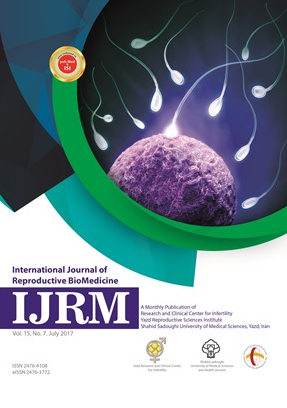
International Journal of Reproductive BioMedicine
ISSN: 2476-3772
The latest discoveries in all areas of reproduction and reproductive technology.
Platelet-rich plasma in the management of Asherman's syndrome; An RCT
Published date:Mar 15 2020
Journal Title: International Journal of Reproductive BioMedicine
Issue title: International Journal of Reproductive BioMedicine (IJRM): Volume 18, Issue No. 2
Pages:113 - 120
Authors:
Abstract:
Background: Asherman’s syndrome (AS) is a rare reproductive abnormality, resulting in endometrial collapse due to aggressive or recurrent endometritis and/or curettage.
Objective: We aimed to assess the effectiveness of using platelet-rich plasma (PRP) to lower the recurrence rate of intrauterine adhesions (IUAs) following postlysis hysteroscopy.
Materials and Methods: In a nonrandomized controlled study, women aged 20-45 years with AS diagnosed by sonohysterography, 3D sonography, hysteroscopy, or uterosalpingography between May 2018 and September 2018 were included. Patients (n = 30) were divided into case and control groups. Following hysteroscopic adhesiolysis, a Foley catheter was placed into the uterine cavity in all women. After two days, the catheter was removed, and 1-mL PRP was injected into the uterine cavity of women in the PRP (case) group, while the control received no PRP. All controls and subjects underwent diagnostic hysteroscopy 8-10 weeks following the intervention to assess the IUAs according to the American Society for Reproductive Medicine scoring system.
Result: Our results did not reveal any significant difference in the menstrual pattern of either the control or test groups before or after treatment (p = 0.2). Moreover, the IUA stage in both studied groups before and after treatment was similar (p = 0.2). The duration of menstrual bleeding in both studied groups before and after treatment was also similar.
Conclusion: PRP cannot decrease the menstrual pattern or development of postsurgical IUAs, as evaluated by follow-up hysteroscopy.
Key words: Asherman’s syndrome, Platelet-rich plasma, Pregnancy rate.
References:
[1] Patterson AL, Zhang L, Arango NA, Teixeira J, Pru JK. Mesenchymal-to-epithelial transition contributes to endometrial regeneration following natural and artificial decidualization. Stem Cells Dev 2013; 22: 964–974.
[2] Yu D, Wong YM, Cheong Y, Xia E, Li TC. Asherman syndrome-one century later. Fertil Steril 2008; 89: 759–779.
[3] Dmowski WP, Greenblatt RB. Asherman's syndrome and risk of placenta accreta. Obstet Gynecol 1969; 34: 288–299.
[4] Conforti A, Alviggi C, Mollo A, De Placido G, Magos A. The management of Asherman syndrome: a review of literature. Reprod Biol Endocrinol 2013; 11: 118.
[5] da Silva RT, Heidrich F. Therapy with use of platelet-rich plasma in orthopedics and sports traumatology: Literature review, evidence and personal experience. Platelet-Rich Plasma 2014: 153–170.
[6] Chang Y, Li J, Chen Y, Wei L, Yang X, Shi Y, et al. Autologous platelet-rich plasma promotes endometrial growth and improves pregnancy outcome during in vitro fertilization. Int J Clin Exp Med 2015; 8: 1286-1290.
[7] El-Sharkawy H, Kantarci A, Deady J, Hasturk H, Liu H, Alshahat M, et al. Platelet-rich plasma: growth factors and pro-and anti-inflammatory properties. J Periodontol 2007; 78: 661–669.
[8] Zadehmodarres S, Salehpour S, Saharkhiz N, Nazari L. Treatment of thin endometrium with autologous platelet-rich plasma: a pilot study. JBRA Assist Reprod 2017; 21: 54–56.
[9] Jang HY, Myoung SM, Choe JM, Kim T, Cheon YP, Kim YM, et al. Effects of autologous platelet-rich plasma on regeneration of damaged endometrium in female rats. Yonsei Med J 2017; 58: 1195–1203.
[10] The American Fertility Society. The american fertility society classifications of adnexal adhesions, distal tubal occlusion, tubal occlusion secondary to tubal ligation, tubal pregnancies, mullerian anomalies and intrauterine adhesions. Fertil Steril 1988; 49: 944–955.
[11] Alawadhi F, Du H, Cakmak H, Taylor HS. Bone marrow-derived stem cell (bmdsc) transplantation improves fertility in a murine model of asherman's syndrome. PLoS One 2014; 9: e96662.
[12] Figueira PG, Abrão MS, Krikun G, Taylor HS. Stem cells in endometrium and their role in the pathogenesis of endometriosis. Ann N Y Acad Sci 2011; 1221: 10–17.
[13] Tan J, Li P, Wang Q, Li Y, Li X, Zhao D, et al. Autologous menstrual blood-derived stromal cells transplantation for severe Asherman's syndrome. Hum Reprod 2016; 31: 2723–2729.
[14] Zhang S, Tan J, Li P. Co-transplantation of menstrual stromal cell and platelet-rich plasma improves asherman's syndrome in rat model. Fertil Steril 2017; 108: e193.
[15] Eftekhar M, Neghab N, Naghshineh E, Khani P. Can autologous platelet rich plasma expand endometrial thickness and improve pregnancy rate during frozen-thawed embryo transfer cycle? A randomized clinical trial. Taiwan J Obstet Gynecol 2018; 57: 810–813.
[16] Aghajanova L, Cedars MI, Huddleston HG. Platelet-rich plasma in the management of Asherman syndrome: case report. J Assist Reprod Genet 2018; 35: 771–775.
[17] Mohamed Amer MI, El-Sayed Ahmed M, Mokhtar Kamal R, Abd Elwahab Torky AMM. The value of using platelet rich plasma after hysteroscopic analysis of severe intrauterine adhesions (a randomized controlled trial). The Egyptian Journal of Hospital Medicine 2018; 71: 2869–2874.
[18] Aghajanova L, Houshdaran S, Balayan S, Manvelyan E, Irwin JC, Huddleston HG, et al. In vitro evidence that platelet-rich plasma stimulates cellular processes involved in endometrial regeneration. J Assist Reprod Genet 2018; 35: 757–770.